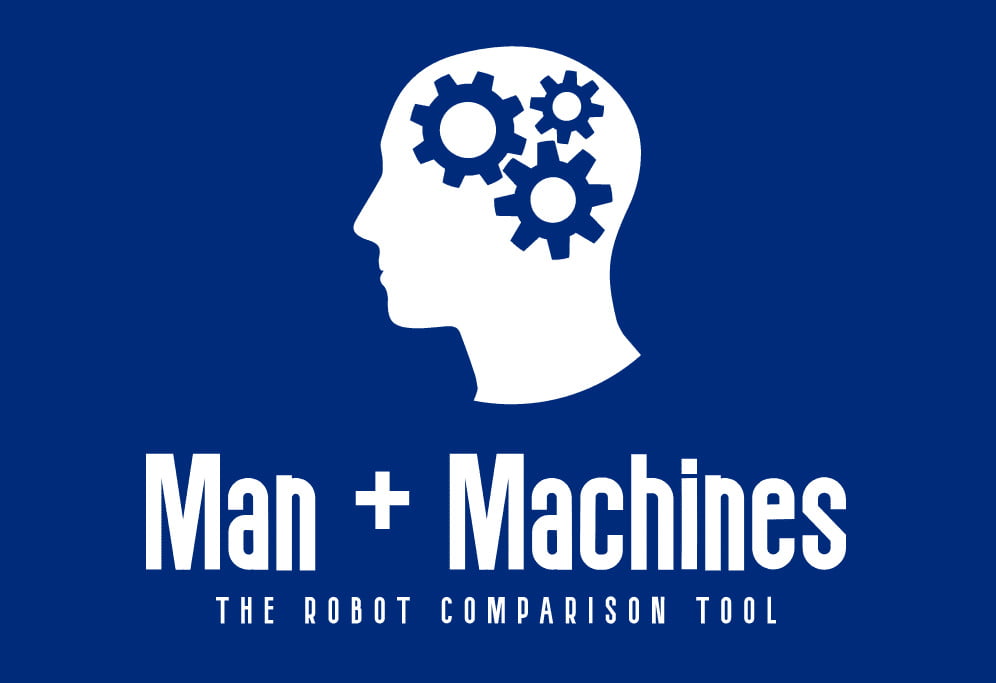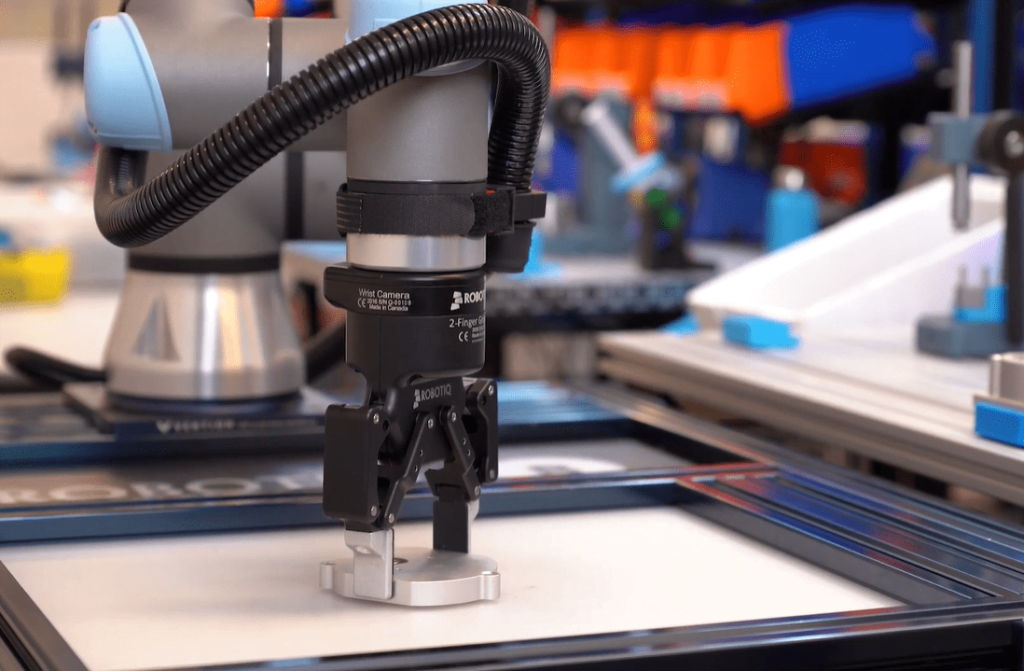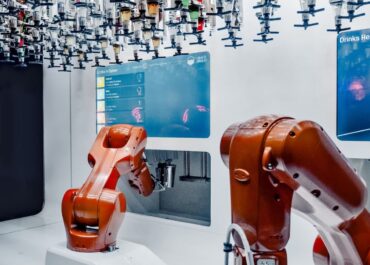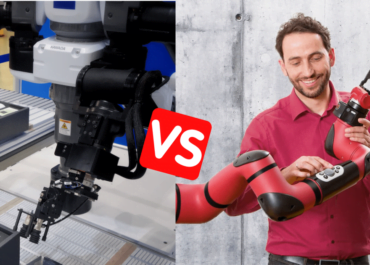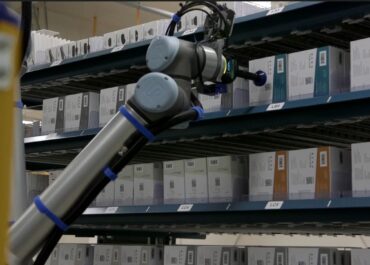Pick & place is one of the most straightforward collaborative robot applications. With flexible and versatile arms, cobots can easily move parts from one place to another.
So there’s no surprise to see manufacturers using them to automate their part-feeding processes. But, depending on the parts’ size, shape and weight, you won’t use the same cobot model or type of gripper.
You won’t also integrate the same robotic solution with more complex pick-and-place applications (like bin picking).
Here’s a complete guide to help you run an efficient pick-and-place collaborative application.
Why use cobots for your pick & place applications?
Picking, moving, and sorting industrial parts every day is a boring task for average industrial workers.
They have to perform repetitive movements to move parts from one conveyor, bin, or machine to another. So it’s often hard to attract and retain employees on these processes.
Moreover, manual pick & place might imply inconsistent and varying input. One day, your workers perfectly place parts into the machines; another day they are distracted and make mistakes. By slowing the overall process, human input can thus reduce throughput and part quality.
Collaborative robot arms are a great alternative, as they can pick, with consistent and precise movements. Compared to traditional industrial robots, they are also easy to set up, quick to program, and redeploy on other picking and loading processes.
When automating your pick and place processes with cobot, you can expect many benefits :
- Getting rid of production bottlenecks and increasing throughput in your part feeding processes.
- Improving input consistency and quality.
- Speeding up highly variable picking process (like bin picking) thanks to intelligent features.
- Freeing up your workers from these tedious tasks, so that they can focus on machine monitoring or other more rewarding tasks.
Are these benefits appealing to you? Here’s where to start.
Pick & place cobots: the best models
Every cobot models on the market can handle pick and place applications, but some of them are an especially great fit for these tasks. Here are 4 outstanding picking cobots :
Universal Robot

Market leader, Universal Robot provides the most versatile cobot models to date. Thanks to a wide spec range, lightweight design, and easy programming, they can be deployed on any picking and moving applications. They also connect to a wide network of third-party grippers and vision systems.
ABB

ABB cobots are known for working well with pick-and-place applications. 2-arm ABB Yumi for example can handle parts with high accuracy and unbeatable performance. The latest models ABB GoFa and SWIFTI are even faster, as they provide industry-like speed and can work continuously without human input.
Techman-Omron

Do you want a cobot with built-in machine vision to automate your bin picking tasks? Techman cobots are good options, as they provide an easy-to-train and reliable vision system embedded in their robot arms. They can detect barcodes and pick the right part in the right way.
Automata

Picking lightweight glasses, samples and parts can be a tough challenge. Automata cobot, Eva, is a great fit for laboratories and specialized industries to precisely handle delicate parts. Its small-scale robot arm can reach tight spaces and is easy to program for automation starters.
Which grippers for your pick & place tasks?
Choosing the right gripper for your pick-and-place application is essential. Depending on the size, shape, and weight of your parts and the work environment, you won’t need the same end effector attached to your robot arm. Some brands have built a wide range of cobot grippers to get you started :
OnRobot

Leader in the market, OnRobot offers a lot of collaborative gripping options. RG 2-finger grippers can firmly grab various parts from any rotation bracket, have customizable fingertips and can have augmented sensing capabilities.
A 3-finger gripper can also handle many non-standard shapes like cylindrical objects. The electrically driven vacuum grippers don’t need any air supply and can be fully customized to adapt to different sizes, shapes, and payloads. OnRobot also provides magnetic, soft, and gecko that supports more specialized parts and environments.
Robotiq

An experienced company in this field, Robotiq provides a various range of high-end grippers. 2F-85 and 2F-140 Grippers have plug-and-play designs, customizable wide strokes, and reliable gripping mechanisms. Hand-E Gripper handles parts with high accuracy and high payload for demanding applications. The 3-finger gripper can grab any shape and form with great stability. Robotiq vacuum grippers support many handling options, are quick to set up, and can run without an air supply.
Schunk

Schunk is already well-known for its robust gripping solutions. It has also built a gripper suited for collaborative applications. The Co-act gripper is fully certified, has a reliable conception, and handles parts with flexible force. It is available in any variant to fit your precise industrial requirement.
Piab

Piab is a large industrial group with extended expertise in gripping technologies. They manufacture vacuum cobot grippers for picking, packing, and palletizing applications. With their Kenos and piCOBOT range, they deliver a compact, secure, flexible, and easy-to-change vacuum gripper kit. They are also easily customizable with the other pumps of the group.
Which tools for intelligent bin picking ?
Picking and replacing a part is one thing, actively detecting it, sorting it, and moving it is another. That’s especially important if you have a process with many part variations like bin picking. You want to make sure your robot can grab the part in the right way and place it in the right place. There are machine vision tools that can help you with that :
ActiNav

ActivNav is the Universal Robot response to the challenge of bin picking. This vision sensor can scan a thousand parts in varying light conditions and help the UR robots pick randomly oriented and placed parts. It’s a flexible solution to automate complex pick-and-place applications.
Pickit

Pickit has built over the years an expertise in robot vision. Their numerous 3D vision sensors can help you manage semi-structured and randomized bin picking applications. They can help your robot figure out the right orientation and position when handling randomly placed parts. They can also help them put them in the right order or position in a machine.
Keyence

The Keyence 3D-Vision guided robotic sensor provides a ready-to-use bin picking application. The 4 cameras and projector create an image free of blind spots and allow for the stable detection of targets regardless of position or orientation. The software provides automatic path planning and modeling simulation to make the setup more accurate than ever. It can greatly assist your robot in picking randomized and hard-to-grab parts.
How to implement your picking cobot in your workshop: a step-by-step guide
Adding a cobot to your manufacturing processes requires a well-thought-out plan. There are a lot of things to consider, so here are 5 steps to guide you through this process :
1. Define your resources and needs
Depending on your industrial needs, you might have different goals in mind for your robotic solution.
Do you want to increase throughput and reduce cycle times in your pick-and-place applications? Do you want to improve output consistency with more precise machine loading and bin picking? Do you want to free up your highly skilled workers for more technical tasks?
You should also consider your existing resources, like human talents, workshop space, and budget. That way, you can figure out the key elements of your buying decision.
2. Choose the right cobot, gripper, or vision tool
When you know what you’re aiming for, it’s time to compare the different robotic picking solutions on the market :
- Technical specs: do the payload and repeatability of the robot work with your part requirements ? Do its size, weight, and reach fit in your cell and machine environment? Does it provide an intelligent vision sensor to handle varying parts?
- User experience: is the robot easy to program without prior technical knowledge?
- Flexibility: is the robot quick to set up and redeploy on new production settings (other kinds of bins, parts, and machines)? Does the gripper easily adapt to new part configurations?
- Safety: do the robot have built-in safety features to prevent collisions with workers? Is the gripper certified ?
3. Restructure your pick-and-place working cell
Your pick-and-place cobot is not just another addition to your manufacturing line. To leverage the benefits of this automation solution, you need to restructure your working cell. For example, open up the workspace to let operators freely check the robot and get back to their occupations.
You also need to redefine the role of your workers. Who will supervise the robot operation, program and deploy it, manage the machine and conveyors, or focus on more high-value tasks? That’s up to you to decide.
4. Make a rigorous safety assessment
Collaborative robots are made to be safe alongside workers. But that doesn’t mean your working application is safe. You still have to assess how your robot, tools, parts, machines, and environment are interacting with your workers. You should consider any potential hazards and ways to mitigate the risks.
5. Ensure your employees are well-trained
Your employees are the primary users of your robotic solution, so they need to know how to manage and leverage it. This means you need to ensure they have the educational resources and training needed to make their work more efficient. Besides, if they are feeling in control, they will better accept this new automation solution in the factory.
Do you have a clearer vision on how to automate your picking applications? Your turn to try and experiment with cobots.
